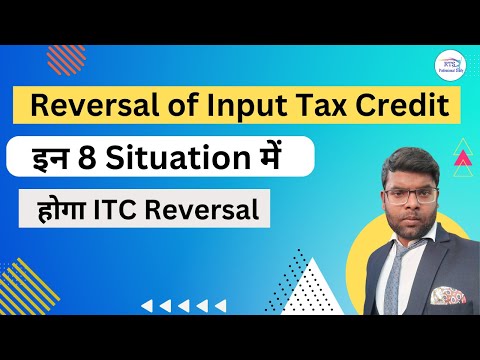Key Takeaways
- The Input Tax Credit (ITC) must be reversed if the payment for inputs or services is not made within 180 days from the invoice date, impacting cash flow and tax liability.
- Rule 37 of GST, requiring timely payment for invoices to claim ITC, aims to prevent tax evasion and ensure financial discipline among businesses.
- Businesses must maintain meticulous records and ensure timely GST filings to remain eligible for claiming ITC and to comply with GST regulations.
- Reversing ITC not only affects financial statements but also necessitates careful monitoring and adjustments in subsequent GST filings to reclaim the credit.
- Partial payments within 180 days require proportional ITC reversals, demanding precise calculations and robust documentation to manage compliance effectively.
The Goods and Services Tax (GST) introduced a transformative shift in the tax framework of India, bringing about a more comprehensive and unified approach to taxation of goods and services across the country. One of the key features of GST is the Input Tax Credit (ITC), which aims to reduce the cascading effect of taxes and promote a seamless flow of credit throughout supply chains. However, managing ITC effectively involves understanding its complexities, especially the conditions under which it must be reversed.
One critical aspect that businesses must vigilantly manage is the 180-day rule concerning ITC reversal. This rule mandates that if the payment for inputs or input services is not made within 180 days of the invoice date, the availed ITC must be reversed. This has significant implications for cash flow management and tax liability.
Understanding ITC Reversal in GST
Credit of Input tax is a critical feature of the Goods and Services Tax (GST) that allows businesses to deduct the taxes paid on their inputs from the taxes they need to pay on their output. This means if a business buys products or services that are subject to GST, they can reduce the amount of GST they have to pay on their sales by the amount of GST they paid on their purchases.
However, the GST law stipulates conditions under which this claimed ITC can be reversed. The reversal typically becomes necessary when the payment for the input goods or services is not made within 180 days of the invoice date. This rule is designed to ensure that credits are only claimed when the actual payment is made, which helps maintain the integrity and flow of the tax system.
Criteria for Reversing ITC
Reversing ITC in GST is not just limited to delayed payments. There are several conditions under which a business must reverse its claimed ITC:

- Non-payment of invoice within 180 days: As mentioned, one of the primary reasons for ITC reversal is the non-payment of the invoice within 180 days from the issue date of the invoice. Once the payment is made, the ITC can be reclaimed in the subsequent GST filing.
- Goods returned or unsatisfactory services: If the goods are returned or services are found to be unsatisfactory after the ITC has been claimed, the corresponding ITC needs to be reversed.
- Personal use or non-business use of inputs: If the inputs or services for which ITC has been claimed are later used for personal purposes or are excluded from the scope of business, the ITC claimed on such inputs needs to be reversed.
- Change in the usage of inputs: If the purpose or the usage of the inputs changes after the ITC has been claimed, such as shifting from taxable to exempt supplies, the previously claimed ITC should be reversed accordingly.
Eligibility for Claiming Input Tax Credit Under GST
To be eligible for claiming Input Tax Credit (ITC) under the Goods and Services Tax (GST) regime, a business must satisfy several conditions that ensure compliance and proper documentation. These requirements are designed to streamline the tax process and prevent fraud. Here are the key criteria that must be met:
- Valid Tax Invoice or Debit Note: The taxpayer must possess a tax invoice or debit note issued by a registered supplier. This document is crucial as it serves as proof of the GST paid on purchases.

- Receipt of Goods and Services: The taxpayer must have actually received the goods or services. This is to confirm that the inputs claimed for the ITC are for real acquisitions and are used in the course of business.
- Supplier has Paid GST to the Government: It is crucial that the supplier who has provided the goods or services has paid the corresponding GST to the government. This condition ensures that the credit claimed is backed by actual tax revenue received by the government.
- GST Returns Filed: The taxpayer claiming the ITC must be up to date with their GST filings. They should have filed the returns under GST in the form GSTR-3B, which summarizes the total purchases and the GST credit claimed.
- Goods not Used for Personal or Exempt Supplies: ITC cannot be claimed on goods or services used for personal purposes or for making exempt supplies. This ensures that the tax credit mechanism is used only for business expenditures connected with taxable supplies.
By meeting these criteria, businesses can effectively claim ITC, which can significantly reduce their tax liability and enhance cash flow management.
Exploring Rule 37 of GST
Rule 37 of the GST laws specifically deals with the reversal of Input Tax Credit (ITC) in cases where the payment for the inputs or input services has not been made to the supplier within 180 days from the date of the invoice. This rule is an essential aspect of the ITC mechanism and serves several important purposes:
Purpose of Rule 37:
- Ensures Timely Payment: This rule encourages businesses to make timely payments to their suppliers. By linking the eligibility of ITC to the payment of invoices, it ensures that businesses cannot indefinitely defer payments.
- Prevents Tax Evasion: It helps prevent potential tax evasion that could occur if businesses claim ITC without actually paying their suppliers.
- Improves Cash Flow for Suppliers: By ensuring that payments are made within 180 days, it helps suppliers maintain a healthier cash flow, which is crucial for the stability of businesses, particularly small and medium enterprises.
Mechanism of Rule 37:
- If the recipient fails to pay the supplier within 180 days, the ITC initially claimed on that purchase must be added back to their output tax liability, along with interest. This amount must be reflected in the GST returns filed for the period during which the 180 days expire.
- Upon payment to the supplier, the ITC can be reclaimed provided all other conditions are still met.
This rule is a crucial control mechanism within the GST framework to ensure that the credit system is not misused and that there is a genuine transaction backing every claim of ITC.
The Significance of Rule 37 in GST
Rule 37 of the GST guidelines plays a pivotal role in maintaining the integrity and efficacy of the Input Tax Credit (ITC) system within the broader GST framework. This rule specifically addresses the conditions under which ITC must be reversed if payment is not made to suppliers within 180 days of receiving an invoice. Here are some critical aspects that highlight the significance of Rule 37:
Promotion of Financial Discipline: By requiring the reversal of ITC if invoices are not paid within the specified timeframe, Rule 37 encourages businesses to adhere to good financial practices by ensuring timely payment to their suppliers. This helps in maintaining liquidity in the market and ensures that businesses do not misuse the credit system to manage cash flow irregularities.
Protection Against Tax Evasion: This rule acts as a safeguard against potential tax evasion attempts where businesses could claim ITC without actually completing the financial transaction. By linking the credit claim to the actual payment, Rule 37 minimizes the risk of fraudulent claims.
Ensuring Compliance: Rule 37 reinforces the compliance aspect of the GST law. It mandates regular monitoring of transactions and adherence to the tax payment deadlines, thus integrating a self-regulating mechanism within businesses to stay aligned with tax regulations.
Supporting Suppliers’ Cash Flow: The rule indirectly benefits suppliers by promoting timely payments, which in turn supports their operational and financial stability. This is particularly beneficial for small and medium-sized enterprises that operate on thin margins and rely heavily on consistent cash flow to manage their expenses.
Overall, the importance of Rule 37 lies in its role in strengthening the accountability and efficiency of the GST system, ensuring that all stakeholders remain compliant and that the tax benefits are accurately and fairly realized.
💡If you want to pay your GST with Credit Card, then download Pice Business Payment App. Pice is the one stop app for all paying all your business expenses.
How Rule 37 Affects GST Filings?
Rule 37 has a direct and significant impact on how businesses prepare and file their GST returns. The need to reverse ITC if payment is not made within 180 days imposes specific reporting requirements and procedural compliance from taxpayers. Here is how it influences GST filings:
| Aspect | Description |
|---|---|
| Adjustment in GST Returns | Businesses must meticulously monitor their invoices and corresponding payments. If a purchase is not paid for within 180 days, the ITC claimed must be reversed in the GST return for the month when the period expires, requiring adjustments in the form GSTR-3B. |
| Detailed Record Keeping | To comply with Rule 37, businesses need to maintain detailed records of all invoices and payments. This is essential for supporting adjustments in GST filings and can be critical during audits. |
| Reclaiming ITC Post-Payment | If a business makes the payment after having reversed the ITC, they can reclaim the ITC in the GST returns of the month during which the payment is made. This process requires additional entries and tracking in subsequent filings. |
| Impact on Cash Flow | The reversal of ITC increases tax liability temporarily, potentially causing cash flow issues. This effect is significant in industries with long credit periods or frequent disputes over supplies. |
| Continuous Compliance Monitoring | Businesses must continuously monitor their compliance with Rule 37 as part of their routine GST reconciliation processes. This includes verifying that payments are made for each invoiced item claimed for ITC to ensure ongoing compliance. |
Accounting for Rule 37 in Financial Records

Rule 37 of the GST regulations significantly influences how businesses manage their financial records. It requires meticulous attention to the tracking of Input Tax Credits (ITC) and their reversal if conditions are not met. Here’s a breakdown of the key accounting practices needed to comply with Rule 37:
Recording ITC and Payments:
- Initial Entry: When an invoice is received, and ITC is claimed, the ITC amount should be recorded as an asset in the financial records. This reflects the tax credit that the business expects to deduct from its GST payable.
- Payment Tracking: Each invoice should be paired with its corresponding payment entry to monitor when the payment is made. This is crucial for ensuring compliance with the 180-day payment condition specified by Rule 37.
Reversal of ITC:
- Automatic Reversals: If the payment for an invoice is not made within 180 days, the previously recorded ITC must be reversed. This reversal is recorded as an increase in GST liability, effectively increasing the amount the business owes the government temporarily.
- Journal Entries: The accounting entry to reverse the ITC typically involves debiting the GST liability account and crediting the ITC asset account. This entry should be clearly documented and justified in the books of accounts.
Reclaiming ITC Upon Payment:
- Payment Made After 180 Days: If the payment is subsequently made after the ITC has been reversed, the ITC can be reclaimed. The journal entry for this would involve debiting the ITC asset account and crediting the GST liability account, thus restoring the ITC.
- Documentation: It’s essential to maintain documentation of the payment and the corresponding journal entry to reclaim the ITC. This documentation will be necessary for GST audits and reconciliations.
Impact on Financial Statements:
- Short-term Fluctuations: The need to reverse and potentially reclaim ITC can lead to short-term fluctuations in tax liabilities and assets on the balance sheet.
- Profit and Loss Account: Fluctuations in ITC due to Rule 37 also affect the profit and loss account as they might increase or decrease the tax expense reported in the period of reversal or reclaim.
Ongoing Compliance and Audit Trails:
- Continuous Monitoring: Businesses need to continuously monitor the status of all invoices and their payment timelines to manage ITC correctly and avoid compliance issues.
- Audit Trails: Proper records and clear audit trails must be maintained to support all entries related to ITC claims, reversals, and reclaims. These records are vital for both internal audits and potential inquiries from tax authorities.
By adhering to these accounting practices, businesses can ensure that they remain compliant with the conditions of Rule 37, thereby minimizing potential tax liabilities and penalties from non-compliance. Additionally, well-maintained financial records help in accurate financial reporting and provide valuable insights for financial planning and analysis.
Consequences of Not Paying Within 180 Days
Under the GST framework, specifically following Rule 37, there are several critical consequences for businesses that fail to make payments for their inputs within 180 days of receiving the invoice. This rule is enforced to ensure timely financial discipline among businesses and to maintain the integrity of the Input Tax Credit (ITC) system. Here are the key consequences of not adhering to this rule:
Reversal of Claimed ITC:
- The most immediate impact is the mandatory reversal of the ITC that was claimed on the invoice. If the payment is not made within the stipulated 180 days, the ITC that had previously been availed must be added back to the output tax liability in the GST return due for that period. This reversal increases the GST payable by the business for that particular tax period.
Financial Implications:
- Increased Tax Liability: The reversal of ITC increases the tax liability of the business, which can have significant cash flow implications, particularly for cash-strapped or small and medium enterprises.
- Interest Charges: In addition to the increased tax liability, businesses are also liable to pay interest on the amount of the reversed ITC from the date it was availed until it is reversed. This can further strain financial resources.
GST Compliance and Penalties:
- Compliance Issues: Non-compliance with the 180-day payment rule can lead to complications during GST audits. Discrepancies like these are red flags for tax auditors and can lead to more rigorous scrutiny of all GST filings.
- Penalties for Non-compliance: If the non-payment and subsequent ITC reversal are flagged during an audit, it could result in penalties besides the interest on the reversed ITC. The penalties depend on the nature of the non-compliance but can be severe to deter repeated violations.
Impact on Business Relationships and Credit Terms:
- Supplier Relationships: Delayed payments can strain relationships with suppliers who expect timely payments for their invoices. This might lead to less favorable credit terms in future transactions or a reluctance on the part of suppliers to do business.
- Credit Rating: Consistent failures to adhere to payment deadlines can also impact a business’s credit rating, making it harder to secure loans or credit lines in the future.
Documentation and Record-Keeping Challenges:
- Increased Administrative Burden: Businesses need to keep meticulous records not only of their ITC claims but also of their payment dates to ensure compliance with Rule 37. This increases the administrative burden and necessitates robust accounting systems.
- Audit Trail: Adequate documentation must be maintained to provide a clear audit trail for transactions to defend the tax positions taken during periodic audits by tax authorities.
Overall, the failure to pay invoices within 180 days and the consequent need to reverse ITC claims under GST Rule 37 pose several challenges and potential penalties for businesses. These range from increased financial liabilities to potential harm to business relationships and reputation. Ensuring timely payments not only helps in maintaining compliance but also supports good business practices and financial stability.
💡If you want to pay business expenses such as Vendors, Rent, GST with Credit Card, then download Pice Business Payment App. Pice is the one stop app for all paying all your business expenses.
Handling Partial Payments of GST Within 180 Days
In the context of GST Rule 37, managing partial payments within the 180-day deadline requires careful accounting and compliance efforts to ensure that businesses correctly handle their Input Tax Credit (ITC). Partial payments are common in business transactions, especially in industries where staggered payments are the norm. Here’s how partial payments should be handled under GST to remain compliant:
| Aspect | Description |
|---|---|
| Proportional ITC Reversal | Calculate the ITC to be reversed proportionally to the unpaid portion of the invoice. For example, if 50% of the invoice is paid, then 50% of the ITC claimed must be reversed. This needs to be done within the 180-day period to comply with GST regulations. |
| Documenting Partial Payments | Maintain detailed records of each partial payment against its corresponding invoice. Ensure that payment receipts clearly specify which invoices they are for to facilitate tracking and compliance. |
| Adjustments in GST Returns | Reflect the proportional ITC reversal in the GST returns for the tax period during which the 180-day deadline expires. This adjustment is typically made in the GSTR-3B form under sections dealing with ITC reversals. |
| Reclaiming ITC on Subsequent Payments | If further payments are made after the 180-day period, the ITC for those payments can be reclaimed in the GST returns for the month during which the payment is made. Document these payments meticulously to ensure compliance and facilitate the reclaiming of ITC. |
| Managing Cash Flow Implications | Consider the impact of ITC reversals on cash flow. Strategic financial planning might be required to decide which invoices should be paid off within the 180 days to optimize ITC benefits and manage cash flow effectively. |
| Compliance Monitoring and Audit Readiness | Regularly review transaction records related to ITC claims and reversals for partial payments to ensure ongoing compliance with GST rules. Maintain robust documentation and prepare for external audits by keeping clear records to quickly resolve any queries or discrepancies. |
This table provides a structured overview of how businesses should handle partial payments concerning GST and ITC, ensuring compliance and efficient financial management.
FAQs
What is a Registered Person under GST?
A Registered Person under GST is a taxpayer who is registered under GST and holds a valid GSTIN. This registration allows them to collect GST from their customers and claim Input Tax Credit (ITC) on their purchases. The tax invoice issued by the supplier, which is essential for claiming ITC, must mention the GSTIN of the registered buyer to validate the tax transaction.
How does the Reverse Charge Basis work in GST?
Under the reverse charge basis in GST, the responsibility of paying the tax shifts from the seller to the buyer. This mechanism is triggered under specific situations delineated by the GST Council, such as when purchasing goods or services from an unregistered supplier. The registered buyer, in this case, has to pay the tax directly to the government and can later claim this amount as ITC, subject to all other conditions being satisfied.
What should businesses know about the Issue of Invoice under GST?
The issue of an invoice under GST is a critical process that documents the sale or transfer of goods and services. It is mandatory for registered GST persons to issue a tax invoice as it serves as the primary evidence for a transaction. This invoice must be issued within a stipulated time frame, typically at the time of supply, and is crucial for both the payment of tax and for claiming ITC.
Why is timely Payment of Tax significant in the GST regime?
Timely payment of tax under GST is crucial as it helps maintain a healthy cash flow for the government and ensures compliance with tax laws. For businesses, adhering to payment schedules is essential not only for compliance but also to avoid penalties and interest on late payments. Moreover, the prompt payment of tax is often linked with the eligibility to claim ITC, making it a financially strategic practice as well.
How are discrepancies handled concerning Tax on Payment made after the issue of a Credit Note?
If a credit note is issued after the tax payment on the original invoice, it can adjust future payments of tax to reflect returned goods, discounts, or corrections. The value and tax stated on the credit note will reduce the tax liability in the period it is issued. This is important as it ensures that businesses only pay tax on the net transaction value after accounting for any modifications post the original sale.
What is the relevance of filing an Annual return in relation to the GST Council’s regulations?
Filing an Annual Return under GST is a compliance requirement that consolidates the data for the fiscal year and helps in assessing the overall tax liability and credit for the year. It is scrutinized in accordance with the regulations set by the GST Council. The annual return provides a detailed report of all monthly or quarterly returns filed in the year and is critical for accurate year-end reconciliation of ITC claims and tax payments.








